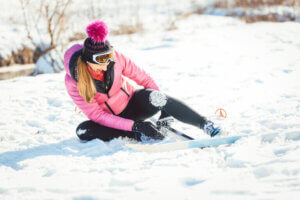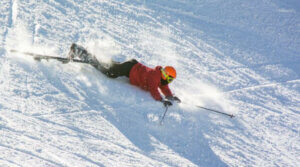Common Injuries in Winter Sports

It’s cold in the winter, and one way to generate heat is through muscle contraction. So, staying active is perfectly understandable. If we add snow to this, we can do things we can’t do at any other time of year. However, these disciplines also have a number of dangers. These are some common injuries in winter sports.
Common injuries in winter sports
Knee injuries
We start the list with this category because the knee is actually one of the joints that suffer the most in sports such as skiing or ice skating. So, if running or changing direction on the solid ground already puts force on the joint, going at higher speeds on slippery terrain will be even worse.
Due to these exaggerated forces, you could tear ligaments by twisting your leg while it’s in contact with the ground. In addition, it could affect both the cruciate and lateral ligaments in this scenario. Also, you could tear your meniscus.
Another common injury is bone edema, mainly after falling. When you fall forward at a high speed, you’re likely to flex your knees and expose your femur. If it hits the ground, it can cause internal bleeding that takes a while to absorb.
Shoulder dislocation
Suffering from a shoulder dislocation is a common injury in winter sports. Again, the main cause is falling. Unless you know how to position your body, you logically try to put your hands out. If you don’t correct this, you fall with all of your weight on your shoulders.

In the second case, a common consequence is a dislocation. In addition to being painful, this injury requires urgent medical attention. Even after popping it back into place, the dislocation will weaken the tissues that surround the joint, such as the joint capsules or ligaments.
However, if you don’t treat it in time, the consequences can get worse. Then, you might have shoulder pain for many years, as well as permanent joint instability.
Fractures
In this section, we’ll talk about a few different types of fractures, depending on how the fall happens. While skating, skiing, and snowboarding, you could fall in a way where you put all of your weight on some bones or others.
It’s common to fracture your wrist if you fall on your hand, or your collarbone if you fall sideways or forward. Also, you could fracture other limb bones, and even vertebrae in severe cases if you fall backward.
Sprains
Finally, we also need to talk about sprains, since they’re also common injuries in winter sports. If you ice skate, you know that ankle sprains are very common. Bending the ankle while trying to move gracefully on the ice with skates is common.
Also, you could fall because your ski becomes stuck in the snow. Similarly, you could sprain your hand or wrist if you fall on it.
Another common injury is knee sprains. As we mentioned earlier, if your knee is exposed to an injury, it could be very severe.
Lastly, it’s worth mentioning that you could injure your thumb while skiing after falling while trying to hold onto the poles. In this case, the stick becomes stuck in the snow and your thumb may bend backward. Therefore, you could sprain or fracture your thumb.
Preventing injuries during winter sports
Finally, here are some tips to prevent other injuries while doing winter sports:
- Physical preparation: it’s important for your muscles and other soft tissues to be warmed up. That way, they’re ready for what you demand of them.

- Using the right equipment for your body: this could be skates, skis, boards, or poles. It’s important to make sure you choose wisely. Also, taking classes to learn how to fall correctly can be very useful.
- Get enough rest: this is very similar to physical preparation. Sure, you want to take advantage of your time in the snow. However, is it worth spending that extra hour skiing or taking a long evening walk instead of letting your body recover? A bath, a short walk around the hotel and sleeping eight hours in a good bed is important to prevent injuries the next day.
- Watch your speed: this is just like driving a car. If you’re going to have an accident, it’s better to be going at a slower speed. For the most part, the consequences of falling largely depend on speed. Always act with your head and watch your surroundings.
Finally, follow the rules. If you want to prevent injuries, don’t go off the trail or insist on jumping off of improvised mountains of snow. Keep an eye on the snow conditions in the morning, and plan your effort based on your skill level.
It’s cold in the winter, and one way to generate heat is through muscle contraction. So, staying active is perfectly understandable. If we add snow to this, we can do things we can’t do at any other time of year. However, these disciplines also have a number of dangers. These are some common injuries in winter sports.
Common injuries in winter sports
Knee injuries
We start the list with this category because the knee is actually one of the joints that suffer the most in sports such as skiing or ice skating. So, if running or changing direction on the solid ground already puts force on the joint, going at higher speeds on slippery terrain will be even worse.
Due to these exaggerated forces, you could tear ligaments by twisting your leg while it’s in contact with the ground. In addition, it could affect both the cruciate and lateral ligaments in this scenario. Also, you could tear your meniscus.
Another common injury is bone edema, mainly after falling. When you fall forward at a high speed, you’re likely to flex your knees and expose your femur. If it hits the ground, it can cause internal bleeding that takes a while to absorb.
Shoulder dislocation
Suffering from a shoulder dislocation is a common injury in winter sports. Again, the main cause is falling. Unless you know how to position your body, you logically try to put your hands out. If you don’t correct this, you fall with all of your weight on your shoulders.

In the second case, a common consequence is a dislocation. In addition to being painful, this injury requires urgent medical attention. Even after popping it back into place, the dislocation will weaken the tissues that surround the joint, such as the joint capsules or ligaments.
However, if you don’t treat it in time, the consequences can get worse. Then, you might have shoulder pain for many years, as well as permanent joint instability.
Fractures
In this section, we’ll talk about a few different types of fractures, depending on how the fall happens. While skating, skiing, and snowboarding, you could fall in a way where you put all of your weight on some bones or others.
It’s common to fracture your wrist if you fall on your hand, or your collarbone if you fall sideways or forward. Also, you could fracture other limb bones, and even vertebrae in severe cases if you fall backward.
Sprains
Finally, we also need to talk about sprains, since they’re also common injuries in winter sports. If you ice skate, you know that ankle sprains are very common. Bending the ankle while trying to move gracefully on the ice with skates is common.
Also, you could fall because your ski becomes stuck in the snow. Similarly, you could sprain your hand or wrist if you fall on it.
Another common injury is knee sprains. As we mentioned earlier, if your knee is exposed to an injury, it could be very severe.
Lastly, it’s worth mentioning that you could injure your thumb while skiing after falling while trying to hold onto the poles. In this case, the stick becomes stuck in the snow and your thumb may bend backward. Therefore, you could sprain or fracture your thumb.
Preventing injuries during winter sports
Finally, here are some tips to prevent other injuries while doing winter sports:
- Physical preparation: it’s important for your muscles and other soft tissues to be warmed up. That way, they’re ready for what you demand of them.

- Using the right equipment for your body: this could be skates, skis, boards, or poles. It’s important to make sure you choose wisely. Also, taking classes to learn how to fall correctly can be very useful.
- Get enough rest: this is very similar to physical preparation. Sure, you want to take advantage of your time in the snow. However, is it worth spending that extra hour skiing or taking a long evening walk instead of letting your body recover? A bath, a short walk around the hotel and sleeping eight hours in a good bed is important to prevent injuries the next day.
- Watch your speed: this is just like driving a car. If you’re going to have an accident, it’s better to be going at a slower speed. For the most part, the consequences of falling largely depend on speed. Always act with your head and watch your surroundings.
Finally, follow the rules. If you want to prevent injuries, don’t go off the trail or insist on jumping off of improvised mountains of snow. Keep an eye on the snow conditions in the morning, and plan your effort based on your skill level.
All cited sources were thoroughly reviewed by our team to ensure their quality, reliability, currency, and validity. The bibliography of this article was considered reliable and of academic or scientific accuracy.
- Physical therapy in the cross country spanish team. S. Caudevilla Polo. S. San Gumersindo Lacasa. P. Fanlo Mazas. C. Hidalgo García. Fisioterapia, Volume 29, Issue 6, December 2007, Pages 278-287
- Lesiones del ligamento cruzado anterior de la rodilla. J. J. Márquez Arabia, W. H. Márquez Arabia. Revista Médica Universidad de Antioquía. Vol. 22, Núm 3
- Ruptura de ligamento cruzado anterior en mujeres deportistas. L. M. Alanís-Blancas, P. Zamora-Muñoz, Á. Cruz-Miranda. Anales Médicos de la Asociación Médica del Centro Médico ABC 2012; 57 (2).
This text is provided for informational purposes only and does not replace consultation with a professional. If in doubt, consult your specialist.








